1. Peer-to-peer recognition, also known as peer recognition, involves employees appreciating each other’s achievements and support, which is crucial for fostering a positive organizational culture.
2. It boosts employee satisfaction, collaboration, empowerment, and transparency while redefining managerial roles.
3. Effective practices include seamless processes, alignment with organizational values, social visibility, program promotion, and regular appreciation events.
4. Clear criteria and appropriate controls can mitigate potential drawbacks.
Increasingly, peer-to-peer recognition is emerging as a popular and effective way to engage and motivate employees across organizations. Experts consider it an essential contributor to building an excellent organizational culture, which impacts employee satisfaction and retention.

Simply put, peer-to-peer recognition or peer recognition is the practice of appreciating, acknowledging, and recognizing co-workers for their achievements, performance, help, or support by anyone in the organization irrespective of their role or level.
Recognition by peers can happen in multiple ways, either in person or digitally. E-cards or ‘thank you’ cards can accompany it or be a token of appreciation.
Peer recognition can be conducted in person at the workplace, during a team meeting, or in any other suitable forum.
Peers can receive recognition digitally through internal collaboration, digital recognition platforms, or social media.
Peer-to-peer recognition is relevant in various situations, including:
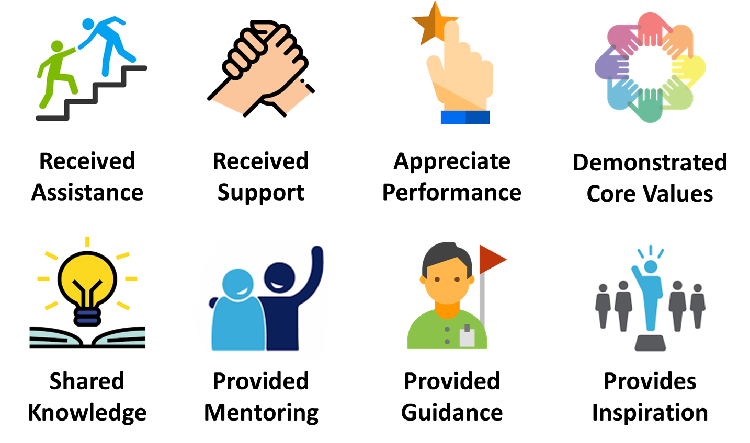
1. Received Assistance
2. Received Support
3. Appreciate Performance
4. Demonstrated Core Values
5. Shared Knowledge
6. Provided Mentoring
7. Provided Guidance
8. Provides Inspiration

In recent years, peer-to-peer recognition has emerged as a powerful tool for motivating employees within organizations.
Being recognized and appreciated by their peers gives employees a greater sense of satisfaction, self-worth, acknowledgment, and achievement.
The critical benefits of peer recognition are as follows:
1. Creates a Great Culture at the Workplace
2. Develop collaboration among Employees
3. Drives Empowerment of Employees
4. Promotes Transparency and Openness
5. Redefines the Role of Managers and Leaders
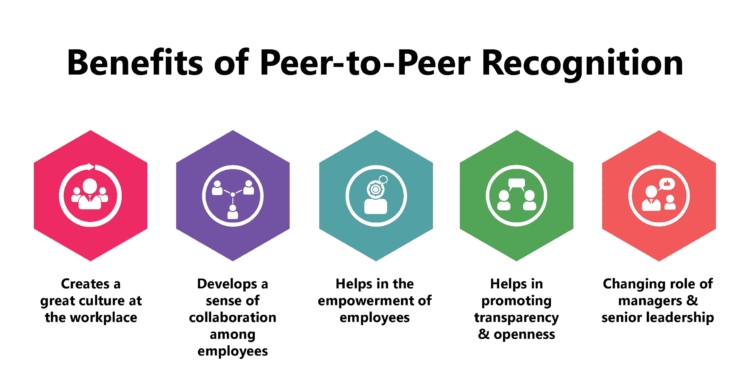
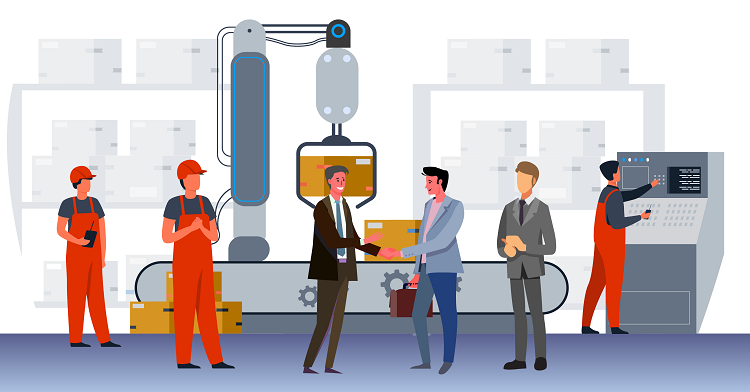
Peer appreciation empowers employees with the tools to praise others, appreciate their accomplishments, and provide positive feedback.
Therefore, this makes them feel truly engaged and helps build a great team.
Moreover, it enables employees to share their views and opinions beyond their assigned tasks and responsibilities.
It contributes to creating a positive work culture and fosters the development of strong interpersonal bonds among employees.

A culture of recognition involving peers helps foster a deep sense of collaboration and camaraderie among coworkers.
Hence, appreciating their colleagues’ contributions and achievements improves team spirit and bonding between team members.

Additionally, recognizing and rewarding coworkers’ efforts and achievements provides employees with positive energy and happiness.
They feel a greater sense of empowerment about the entire process of recognition.
It creates a greater sense of empowerment, thereby ensuring greater participation.
It, in turn, positively impacts employee efficiency and productivity.
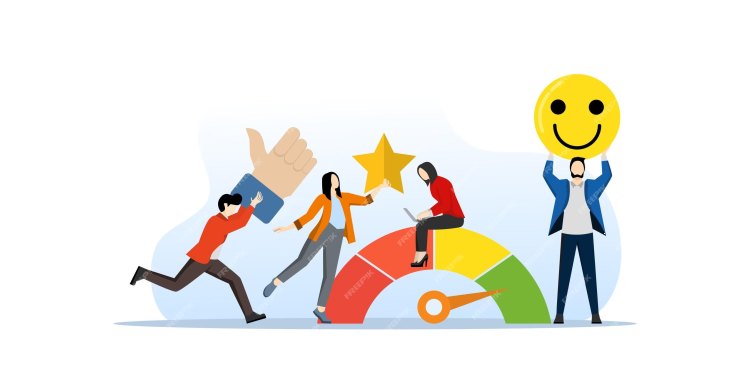
Organizations also strive to create a transparent and open work culture. Hence, implementing peer recognition systems helps enhance trust and camaraderie between employees.
So, employees feel free to share their opinions and express their views in a free and frank manner.
As employees become more open with one another and their superiors, the work environment becomes increasingly transparent.

It is a misconception that the popularity of peer appreciation may make managers and leaders irrelevant in the whole process.
Promoting peer recognition programs will remain the responsibility of the managers.
Also, despite the effectiveness of peer recognition, employees would still want to be appreciated for their achievements by their superiors.
Hence, the management will continue to play a crucial role in employee recognition.

Too much of peer recognition without genuine reasons might diminish its value in the eyes of the employees as well as for the organization.
It might seem like a mere formality rather than a genuine appreciation for a real achievement or action.
Defining clear criteria, even for peer recognition, can ensure its relevance and significance.
Peer recognition might turn into a ‘popularity contest’ for employees who have good informal relationships with other employees.
It will impact the genuineness of the program itself and diminish its value.
Some moderation by supervisors or HR, even for peer appreciation, could ensure that recognition occurs only in genuine cases.
Those employees who are not recognized by their peers, might feel disengaged with the team.
It could lead to a decline in their performance and productivity.
Appreciation from peers must be supplemented by other forms of recognition, driven by the supervisors and the management, to ensure that all deserving employees receive appropriate recognition.
Here are the best practices:
1. Make the Process Seamless
2. Incorporate Organizational Values
3. Create Social Visibility
4. Promote the Program
5. Conduct Appreciation Events
6. Implement Appropriate Controls
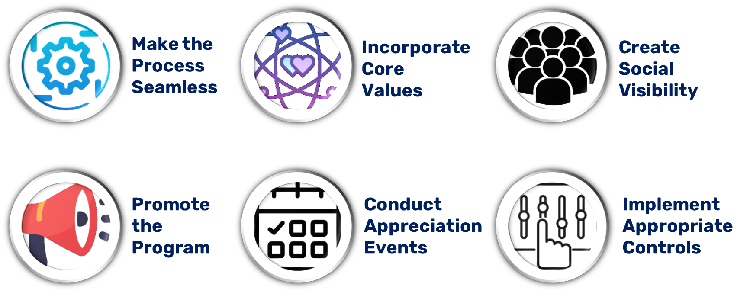

Organizations must make the process of giving and receiving peer acknowledgment seamless and convenient for employees.
One of the best ways to do this is to implement a digital recognition platform, preferably with a mobile app that enables employees to recognize their peers on the go.
Employee recognition platforms can help organizations make recognition from anyone to anyone, anytime and anywhere, a reality, which is challenging for traditional methods such as ‘Thank You’ cards.

Colleagues, being nearby, often have a unique perspective on the behaviors of their team members.
Their observations can be invaluable in the peer acknowledgment process.
Hence, acknowledging peers for demonstrating behaviors that are closely aligned with the organization’s core values should be a priority.

To highlight the importance of peer recognition, there should be social visibility around it.
Physical or online walls of fame, leaderboards, and integration with internal platforms such as Teams, Slack, and intranets could be good ways to showcase peer recognition and create visibility around it.
Peers can receive shout-outs in team meetings and other similar forums.

Regular communication from HR and management about peer recognition is critical to its success.
Such communication can help reinforce the importance of peer appreciation and increase the level of traction in the program.
Emails, collaboration platforms, workplace signage, and other tools can help promote the program within the organization.
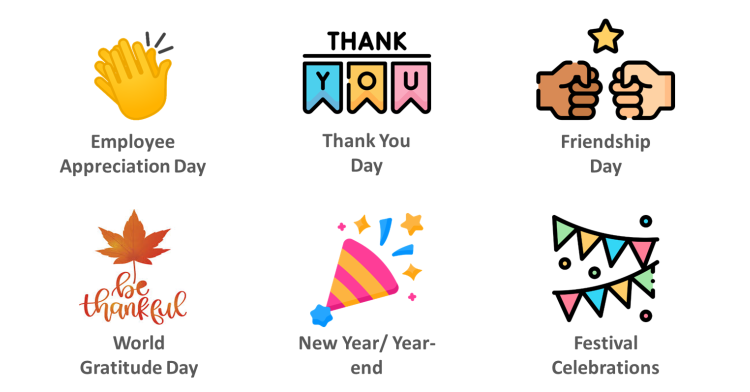
It is a great idea to leverage significant occasions, such as Employee Appreciation Day, World Gratitude Day, or Friendship Day, to promote peer-to-peer recognition within the organization.
The organization can conduct peer appreciation weeks around these events to promote employee recognition.
Such events can help renew employees’ interest in the program by creating more variety and excitement.

Setting appropriate criteria, moderation by the HR or the management, restrictions on the frequency of recognition, etc., are a few of the controls that can be implemented to ensure that the process stays fair and unbiased.
These are important to ensure employees perceive peer recognition as genuine, valuable, and desirable.
Peer-to-peer recognition has become an important part of the workplace today and has been helpful for organizations in improving employee satisfaction and well-being, which directly impacts organizational performance and retention.

Lead author: Sagar Chaudhuri, the Co-Founder and CEO of HiFives. He is an HR Tech Evangelist with over 25 years of experience in both corporate and entrepreneurial settings. Previously, Sagar has held leadership roles with companies such as Genpact, Infosys, and ICICI Bank. He has an engineering degree from IIT Kharagpur and an MBA from IIM Lucknow. Connect on LinkedIn
To stay updated on the latest HiFives blogs, follow us on Twitter (@MyHiFives)